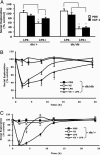Inhibition of vagally mediated immune-to-brain signaling by vanadyl sulfate speeds recovery from sickness
- PMID: 16217019
- PMCID: PMC1257721
- DOI: 10.1073/pnas.0507191102
Inhibition of vagally mediated immune-to-brain signaling by vanadyl sulfate speeds recovery from sickness
Abstract
To the ill patient with diabetes, the behavioral symptoms of sickness such as fatigue and apathy are debilitating and can prevent recuperation. Here we report that peripherally administered insulin-like growth factor 1 (IGF-1) attenuates LPS-dependent depression of social exploration (sickness) in nondiabetic (db/+) but not in diabetic (db/db) mice. We show that the insulin/IGF-1 mimetic vanadyl sulfate (VS) is effective at augmenting recovery from sickness in both db/+ and db/db mice. Specifically, peak illness was reached at 2 h for both VS and control animals injected with LPS, and VS mice recovered 50% faster than non-VS-treated animals. Examination of the mechanism of VS action in db/+ mice showed that VS paradoxically augmented peritoneal macrophage responsivity to LPS, increasing both peritoneal and ex vivo macrophage production of IL-1beta and IL-6 but not TNF-alpha. The effects of VS in promoting recovery from sickness were not restricted to LPS, because they were also observed after direct administration of IL-1beta. To explore the possibility that VS impairs immune-to-brain communication via vagal afferents, the vagally mediated satiety-inducing effects of cholecystokinin 8 were tested in db/+ mice. Cholecystokinin decreased food intake in saline-injected mice but not in VS-treated mice. VS also inhibited LPS-dependent up-regulation of IL-1beta and IL-6 mRNA in the brain, while increasing by 50% the cerebral expression of transcripts of the specific antagonist of IL-1 receptors IL-1RA and IL-1R2. Taken together, these data indicate that VS improves recovery from LPS-induced sickness by blocking vagally mediated immune-to-brain signaling and by up-regulating brain expression of IL-1beta antagonists.
Figures





Similar articles
-
IL-1beta-mediated innate immunity is amplified in the db/db mouse model of type 2 diabetes.J Immunol. 2005 Apr 15;174(8):4991-7. doi: 10.4049/jimmunol.174.8.4991. J Immunol. 2005. PMID: 15814729
-
Central administration of insulin-like growth factor-I decreases depressive-like behavior and brain cytokine expression in mice.J Neuroinflammation. 2011 Feb 9;8:12. doi: 10.1186/1742-2094-8-12. J Neuroinflammation. 2011. PMID: 21306618 Free PMC article.
-
The role of cytokines in the behavioral responses to endotoxin and influenza virus infection in mice: effects of acute and chronic administration of the interleukin-1-receptor antagonist (IL-1ra).Brain Res. 1997 Nov 21;776(1-2):96-104. doi: 10.1016/s0006-8993(97)01009-3. Brain Res. 1997. PMID: 9439800
-
Insulin-like growth factor-I peptides act centrally to decrease depression-like behavior of mice treated intraperitoneally with lipopolysaccharide.J Neuroinflammation. 2011 Dec 21;8:179. doi: 10.1186/1742-2094-8-179. J Neuroinflammation. 2011. PMID: 22189158 Free PMC article.
-
Treatment of diabetes with vanadium salts: general overview and amelioration of nutritionally induced diabetes in the Psammomys obesus gerbil.Diabetes Metab Res Rev. 2001 Jan-Feb;17(1):55-66. doi: 10.1002/1520-7560(2000)9999:9999<::aid-dmrr165>3.0.co;2-j. Diabetes Metab Res Rev. 2001. PMID: 11241892 Review.
Cited by
-
Central CRTH2, a second prostaglandin D2 receptor, mediates emotional impairment in the lipopolysaccharide and tumor-induced sickness behavior model.J Neurosci. 2014 Feb 12;34(7):2514-23. doi: 10.1523/JNEUROSCI.1407-13.2014. J Neurosci. 2014. PMID: 24523542 Free PMC article.
-
TNFalpha-induced sickness behavior in mice with functional 55 kD TNF receptors is blocked by central IGF-I.J Neuroimmunol. 2007 Jul;187(1-2):55-60. doi: 10.1016/j.jneuroim.2007.04.011. Epub 2007 May 18. J Neuroimmunol. 2007. PMID: 17512609 Free PMC article.
-
Analysis of serum inflammatory mediators in type 2 diabetic patients and their influence on renal function.PLoS One. 2020 Mar 4;15(3):e0229765. doi: 10.1371/journal.pone.0229765. eCollection 2020. PLoS One. 2020. PMID: 32130282 Free PMC article.
-
Three questions about leptin and immunity.Brain Behav Immun. 2009 May;23(4):405-10. doi: 10.1016/j.bbi.2008.10.007. Epub 2008 Oct 25. Brain Behav Immun. 2009. PMID: 18996468 Free PMC article. Review.
-
Acute hypoxia activates the neuroimmune system, which diabetes exacerbates.J Neurosci. 2007 Jan 31;27(5):1161-6. doi: 10.1523/JNEUROSCI.4560-06.2007. J Neurosci. 2007. PMID: 17267571 Free PMC article.
References
-
- Konsman, J. P., Parnet, P. & Dantzer, R. (2002) Trends Neurosci. 25, 154-159. - PubMed
-
- O'Connor, J. C., Satpathy, A., Hartman, M. E., Horvath, E. M., Kelley, K. W., Dantzer, R., Johnson, R. W. & Freund, G. G. (2005) J. Immunol. 174, 4991-4997. - PubMed
-
- Bar, R. S., Harrison, L. C., Muggeo, M., Gorden, P., Kahn, C. R. & Roth, J. (1979) Adv. Intern. Med. 24, 23-52. - PubMed
-
- Committee on Biologic Efects of Atmospheric Pollutants, Division of Medical Sciences, Natl. Research Council (1974) Medical and Biologic Effects of Environmental Pollutants: Vanadium (Natl. Acad. Sci., Washington, DC).
-
- Agency for Toxic Substances and Disease Registry (1992) Toxicological Profile for Vanadium and Compounds (U.S. Dept. of Health and Human Services, Public Health Service, Atlanta, GA), USGPO Publication No. 1662-636-281.
Publication types
MeSH terms
Substances
Grants and funding
LinkOut - more resources
Full Text Sources
Other Literature Sources
Medical
Miscellaneous

